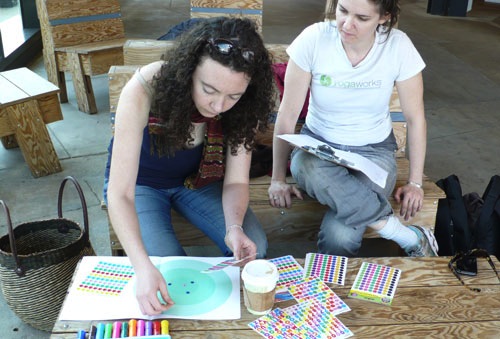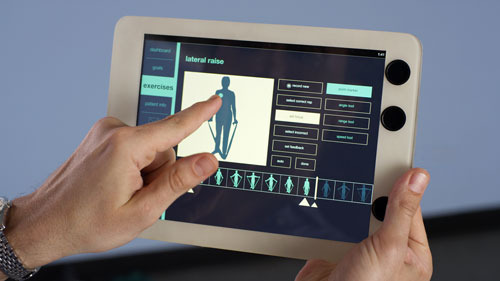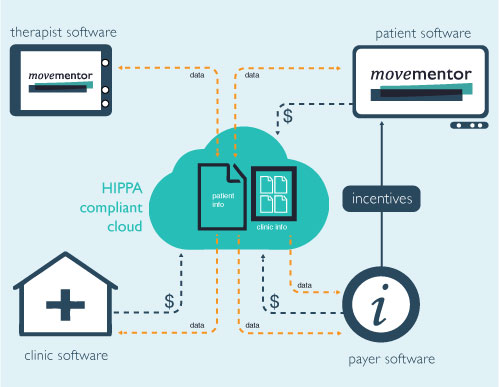
Grad ID student, Lindsay Nevard interviews patients in the service of developing her products for improving patient experience
Lindsay Nevard is a recent graduate of Art Center’s Graduate Industrial Design program whose thesis focused on improving patient outcomes in physical therapy. For the Dotted Line, Alex Moore interviewed Lindsay about the process of design research, juggling the roles of both designer and researcher, and the potential uses of technology to enhance patient experience.
Alex Moore: I think a lot of people are unfamiliar with the idea of design research. Could you elaborate?
Lindsay Nevard: Design research is doing the research so the product is smart. That means making sure that people are going to like it, that people are going to be able to use it easily, and that it fills a need. It can be as big as: “We are going to create something totally new, what are consumers’ latent desires?” Or it can be as detailed as: “How much should our new product cost and what color should it be?” In both cases it is really important to understand the user you are targeting. You also need to determine the appropriate questions or methods to get the answers you need. When doing interviews, you have to get people comfortable talking and into the right state of mind. You try to coax people into a more playful space. If you give someone a literal map of their workplace, they are going to give you a literal answer. But if you give someone LEGO bricks, they can’t build a literal interpretation and you will often gather more interesting information.
Alex: How do you transition from research to design?
Lindsay: How research and design intersect varies. In a corporate setting, often you aren’t just trying to please a user, but also balance the needs of the client. So there are a lot of moving parts. As a researcher you simplify all the information to the essential points so as to communicate them to the client. Moving into design, you think broadly again and you bring back in all the detailed information as the design takes shape. Good research makes design easy.

Lindsay Nevard’s ideation board
Alex: Let’s talk about a couple of your projects. What were the problems you identified and the solutions you developed?
Lindsay: For my thesis, Movementor, my original goal was to innovate for physical therapy. I read journal articles, interviewed physical therapy patients, and started volunteering at a physical therapy clinic. This research revealed the number one issue was patient adherence, and there was an opportunity to improve this using technology. Because I had been thinking about it for so long, the design process was very quick. And I was already in conversation with physical therapists. So as I started designing, I could show them my ideas and get feedback. Especially once I was working on the user interface. Designing an app is the same process as a physical product– you are working out how the user is going to interact with it.

Movementor app
Before my thesis, I designed a product system (Ubrea) for people with severe anxiety. In interviewing therapists and patients, I realized a big gap in the way things are currently done is that people use all these techniques for calming themselves down on the therapist’s couch, but it was hard to implement them outside of that setting because often, by the time you realize you are anxious, it is too late. To solve this, I made a system that monitors peoples’ anxiety and alerts them in a calming manner that they should try their techniques.
Alex: These seem similar in how technology integrates into medical practice.
Lindsay: Yes, both Ubrea and Movementor are meant to improve the therapist-patient relationship, not replace it. People’s emotions and bodies are too complex to be handled with just a device, but technology can be used to enhance the relationship. This would improve patient outcomes and save insurance companies money. Determining how to make the product viable is as essential as figuring out the right color or functionality, because design is a business problem, too.

Alex: Are there any particular problems that you want to tackle next?
Lindsay: I think it would be really interesting to work on an electronic medical record (EMR) system. There is so much room for improvement. My previous degree was in women’s studies and I spent a lot of time thinking about policy. Though seemingly disconnected, both policy and design are ways of assessing how to make systems work better for people. In the case of the EMR, neither policy nor design is going to solve the problem alone; the two approaches need to be used together.
Lindsay Nevard recently graduated from Art Center with an M.S. in Industrial Design.
Alex C Moore is a research consultant and writer based in Los Angeles.








